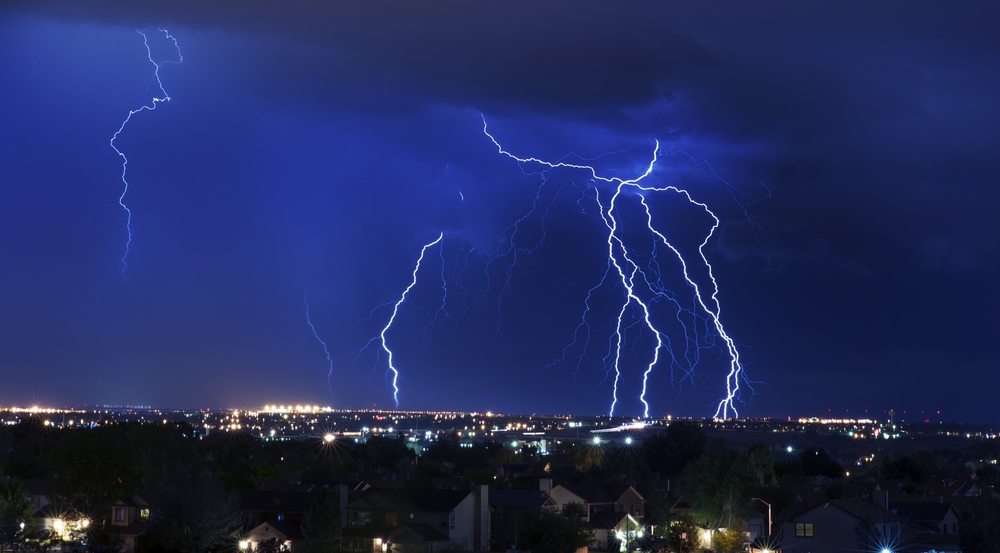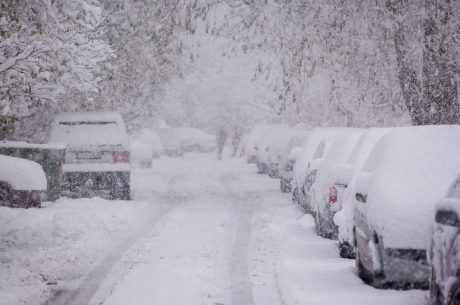The combination of thunderstorms and flooding is spring’s recipe for disaster. If early storms arrive while the snow on the ground hasn’t melted yet, or when the ground is still frozen, the potential for devastating floods increases. And because the weather is so unpredictable this time of year, spring storm preparedness is essential.
What Can You Do to Prepare for Severe Spring Storms?
We can’t change the weather, but we can prepare ourselves to better handle it when it comes. Follow these 10 spring storm preparedness tips to protect yourself, your family, and your property from severe spring weather.
1. Trim Shrubs and Branches Near Home and Powerlines
Make sure no trees or bushes hang over the roof or any windows. During spring storms, these hanging limbs might damage glass and roof shingles and cause other harm. A strong spring storm may easily rip away a loose branch and hurl it through the air. Remove all dead and broken branches. As well, make sure trees and bushes are cleared away from powerlines.
2. Check the Gutters
If your gutters are clogged water can back up into your roof, meaning spring storm damage to your roof is much more likely. This often happens when the ice melts after accumulated winter debris blocks gutters. Keep drains and gutters clean and clear to ensure proper drainage. Also, check to ensure gutters are securely attached to the house to safeguard against strong winds.
3. Clear the Lawn of Debris
Make sure fallen branches and yard debris are picked up and not allowed to accumulate against your home’s foundation, windowsills, or doors. Strong spring storm winds have the potential to blow this right off your lawn towards your home if you don’t take care of it beforehand. When a storm is imminent, secure all loose items in your yard, bringing them inside if possible, and move vehicles and equipment to high ground.
4. Caulk Windows & Doors
The windows and doors in your house may be susceptible to fractures that create the opportunity for spring storm damage that wouldn’t have occurred otherwise. Seal all cracks and gaps around doors with caulk, protecting them from spring storms. Caulking windows and doors help prevent leaks, which can lead to water damage.

5. Inspect The Roof
No matter the type of roof your home may have, be sure to inspect it in the springtime for signs of anything that may have been weakened over winter. Spring storms are usually turbulent and gusty, so any sort of weakness will most likely be taken advantage of.
6. Prepare an Emergency Kit
In case of spring storm emergencies, it’s a good idea to have an emergency kit ready in your house. Include in your kit non-perishable foods and water bottles to last 3-5 days minimum, important prescription and non-prescription medicines, and first aid supplies. Blankets and warm clothes, along with personal hygiene products are also recommended. If you have a pet, make sure you have a spring storm emergency kit prepared for them as well. You should also have a working fire extinguisher handy.
7. Create a Disaster Preparedness Plan
Create a disaster preparedness plan. Establish an outside meeting place and escape routes from each room in your house. Also, practice the plan with family members. Include your pets in the plan and make sure they wear an ID tag. Make sure you and your family know how to turn off utilities and how to use a fire extinguisher.
8. Review Insurance Coverage
When you’re planning ahead for spring storm preparedness, be sure to review your insurance coverage with your agent and make sure you understand what’s covered and what isn’t. It’s generally a good idea to obtain flood insurance, which isn’t included in standard homeowners’ policies. But don’t wait – flood insurance policies take 30 days to go into effect.
Take a home inventory in case you need to file an insurance claim. Also, secure critical information, such as documents, personal numbers, and insurance policies in a waterproof container. After a spring storm passes, take note of any damage to your home so you can follow up with insurance companies who may need proof of spring storm damage. This includes photographing anything that was damaged such as broken windows, fallen trees/branches, etc.
9. Prepare the Garden Shed
Make sure your garden shed and all your tools and equipment are secured. You may not need to go into this during a spring storm but having an idea of what needs protecting is better than nothing. Don’t forget to include the garden shed and any other outbuildings in your inventory.
10. Check Your Sump Pump
If your home has a sump pump, it’s important to ensure that it’s working properly. A sump pump that doesn’t work can contribute to flooding in your home when it fails to remove the incoming water, leaving water damage. Be sure to run through a basic maintenance checklist ahead of time to verify that everything is running smoothly.

Call PuroClean for Property Restoration from Spring Storm Damage
Spring storm preparedness is key to weathering through the storms ahead. Remember, spring doesn’t wait for you to get ready, so make a spring storm preparedness plan now – before a thunderstorm or flood strikes your area. Although preparation is vital, damage can still occur. If it happens to you, call the PuroClean experts, who can determine the full extent of the damage and perform full restoration services following industry standards and best practices. Visit our website or call (800) 775-7876 to get connected with your local PuroClean office 24/7.




